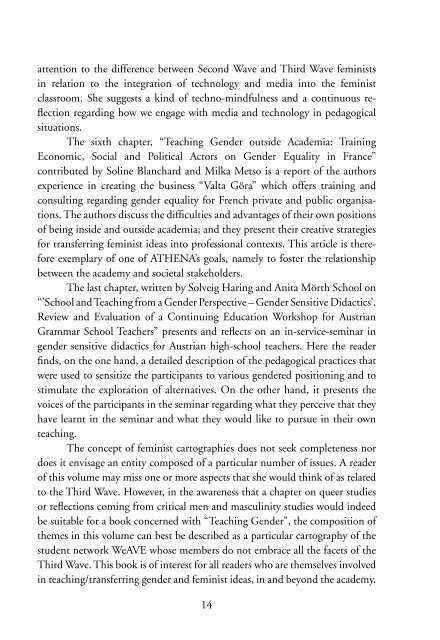Teaching with the third wave new feminists - MailChimp
Teaching with the third wave new feminists - MailChimp
Teaching with the third wave new feminists - MailChimp
You also want an ePaper? Increase the reach of your titles
YUMPU automatically turns print PDFs into web optimized ePapers that Google loves.
attention to <strong>the</strong> difference between Second Wave and Third Wave <strong>feminists</strong>in relation to <strong>the</strong> integration of technology and media into <strong>the</strong> feministclassroom. She suggests a kind of techno-mindfulness and a continuous reflectionregarding how we engage <strong>with</strong> media and technology in pedagogicalsituations.The sixth chapter, “<strong>Teaching</strong> Gender outside Academia: TrainingEconomic, Social and Political Actors on Gender Equality in France”contributed by Soline Blanchard and Milka Metso is a report of <strong>the</strong> authorsexperience in creating <strong>the</strong> business “Valta Göra” which offers training andconsulting regarding gender equality for French private and public organisations.The authors discuss <strong>the</strong> difficulties and advantages of <strong>the</strong>ir own positionsof being inside and outside academia; and <strong>the</strong>y present <strong>the</strong>ir creative strategiesfor transferring feminist ideas into professional contexts. This article is <strong>the</strong>reforeexemplary of one of ATHENA’s goals, namely to foster <strong>the</strong> relationshipbetween <strong>the</strong> academy and societal stakeholders.The last chapter, written by Solveig Haring and Anita Mörth School on“’School and <strong>Teaching</strong> from a Gender Perspective – Gender Sensitive Didactics’.Review and Evaluation of a Continuing Education Workshop for AustrianGrammar School Teachers” presents and reflects on an in-service- seminar ingender sensitive didactics for Austrian high-school teachers. Here <strong>the</strong> readerfinds, on <strong>the</strong> one hand, a detailed description of <strong>the</strong> pedagogical practices thatwere used to sensitize <strong>the</strong> participants to various gendered positioning and tostimulate <strong>the</strong> exploration of alternatives. On <strong>the</strong> o<strong>the</strong>r hand, it presents <strong>the</strong>voices of <strong>the</strong> participants in <strong>the</strong> seminar regarding what <strong>the</strong>y perceive that <strong>the</strong>yhave learnt in <strong>the</strong> seminar and what <strong>the</strong>y would like to pursue in <strong>the</strong>ir ownteaching.The concept of feminist cartographies does not seek completeness nordoes it envisage an entity composed of a particular number of issues. A readerof this volume may miss one or more aspects that she would think of as relatedto <strong>the</strong> Third Wave. However, in <strong>the</strong> awareness that a chapter on queer studiesor reflections coming from critical men and masculinity studies would indeedbe suitable for a book concerned <strong>with</strong> “<strong>Teaching</strong> Gender”, <strong>the</strong> composition of<strong>the</strong>mes in this volume can best be described as a particular cartography of <strong>the</strong>student network WeAVE whose members do not embrace all <strong>the</strong> facets of <strong>the</strong>Third Wave. This book is of interest for all readers who are <strong>the</strong>mselves involvedin teaching/transferring gender and feminist ideas, in and beyond <strong>the</strong> academy.14
















